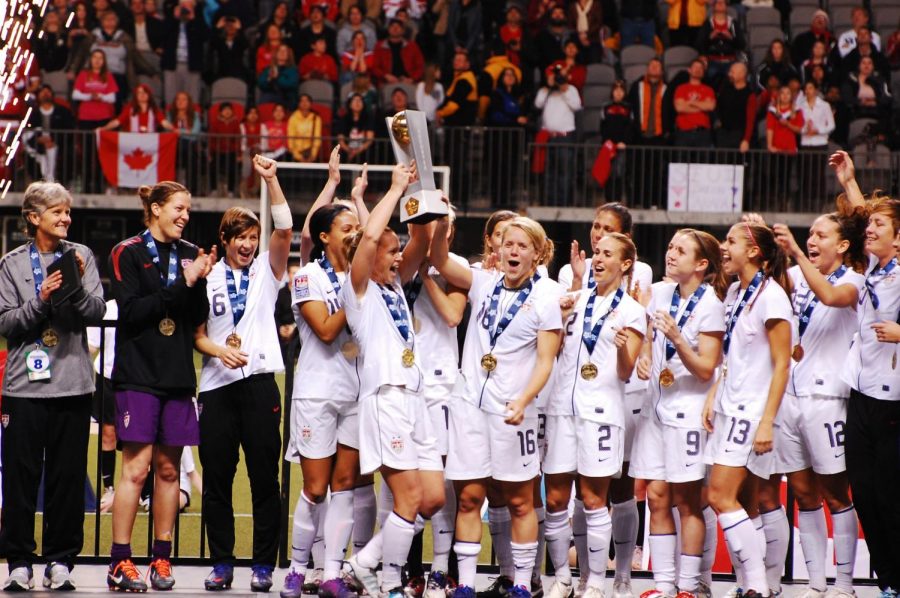US Women’s National Team files lawsuit against US Soccer
December 14, 2019
In March 2019, the United States Women’s National Soccer Team (USWNT) filed a lawsuit against the United States Soccer Federation (USSF), claiming that women were being paid less than their male counterparts for equal work. Though it has gained support from the public, the lawsuit has many complications.
The USWNT has gained recognition in the past couple months for their World Cup win in France over the summer. The team has made a name for itself in recent years, winning three Olympic gold medals and now four FIFA World Cups. Along with their success, the team has gained publicity for their lawsuit against U.S. Soccer. The team cites “gender discrimination” as the reason for their unequal wages.
The USWNT’s charges
The lawsuit charges the USSF for violating the Equal Pay Act and Title VII of the Civil Rights Act, which collectively prevent employers from paying certain employees less on account of gender. The 28 players of the USWNT have been cited as plaintiffs in the lawsuit, claiming that the USSF has paid women less than men for the same job responsibilities. The players insist this reflects gender discrimination.
The USWNT has released evidence and statistics supporting their claims. The complaint states, “From 2013 to 2016, the USSF paid USWNT players $15,000 for trying out and making the World Cup team. Yet the USSF paid USMNT players $55,000 for making the World Cup team.”
Similarly, according to The National Law Review, “In 2014, the USSF paid the USMNT more than $5.3 million in bonuses after their World Cup loss in the Round of 16. While in 2015, the USSF paid the USWNT only $1,725,000 in bonuses after they won the World Cup.”
The complaint furthers that the women are paid less despite performing the same job duties. In some cases, they have even worked more than the men, playing in 19 more games from 2015 to 2018 (The National Law Review).
According to the complaint, the women’s team is also given different benefits than the men. It alleges that “in 2017, USSF chartered private planes for the USMNT travel at least 17 times, but zero times for the USWNT.”
The release of these examples has generated support from the public. Junior Anika Kumar plays soccer and has been watching the USWNT since she was in elementary school. Like many people, the inequality in soccer frustrates her.
“The fact that they are winning more and not getting more is crazy to me,” Kumar said.
The USSF’S defense
In order for U.S. Soccer to counter these claims, they must prove that the pay disparity is due to either a merit system, seniority or better quality or more quantity of work.
A spokesperson for U.S. Soccer told Sports Illustrated that “our men and women’s national teams have different pay structures, not because of gender, but because each team chose to negotiate a different compensation package with U.S. Soccer.”
Many of the women in the USWNT are paid a base salary for completing two tasks: 1) playing and training in the National Women’s Soccer League and 2) playing on the US National team. Their pay does not increase or decrease based on games won or a certain amount of games played. Due to this agreement, their annual salary caps at $172,500.
The men, however, are under a different contract. Their “pay-for-play” contract entails payment only if they make certain rosters for tournaments. Bonuses are then added to this payment based on how successful the teams are. Though this system does not guarantee a higher salary, it gives the men a much higher payment ceiling.
Along with their contractual differences, U.S. Soccer claims another reason for unequal pay is the difference in revenue brought in by the two teams.
U.S. Soccer insists that the men’s team brings in money from advertisements and viewership. The men generate more finances for U.S. Soccer and therefore are paid more and have better playing conditions.
These claims may not be true, as the USWNT complaint states that “the USSF revised its projected earnings for 2016 from a net loss of $429,929, to a net gain of $17.7 million, because of the successes of the USWNT.”
The lawsuit’s progression
Since the start of the lawsuit in March, the USWNT has gained a tremendous amount of support from fans and critics alike. Building upon their encouragement, the team has released numerical evidence demonstrating the glaring pay gap.
These numbers compared the women’s pay rates to those of the men. One particular chart shows that under the USWNT pay rate, four players would earn an average of $1,188,225 from 2014 to 2019. However, under the MNT pay rate, they would have earned an average of $4,042,159.
But U.S. Soccer has put forth numbers contradicting the USWNT’s claims.
In their pleading, U.S. Soccer released their own chart, highlighting the salaries of the highest-paid women’s players.
However, Kumar feels that these claims don’t sound right.
“It’s hard to believe that these strong-motivated women agreed to be paid less because of a contract,” she explained.
Though both sides have wildly different claims and evidence, it is hard to pinpoint a right or wrong in this situation. The contractual differences make it difficult to compare salaries between the two teams.
In September, the players filed a motion for class certification; it passed on Nov. 8. It expanded the scope of plaintiffs to other U.S. women players and also ensured damages be paid to each plaintiff.
The motion proposed three classes of action: 1) damages be paid to all players who have been on the team since March 2016 to the present, 2) payment be given to all USWNT players since February 2015 and 3) all future USWNT players be paid equally.
If the court rules in favor of the USWNT, U.S. Soccer will have to adhere to all three classes of action.
Four out of the 28 players are to serve as class action representatives for the team: Alex Morgan, Megan Rapinoe, Becky Saurbrunn and Carli Lloyd will speak on behalf of the other 24 plaintiffs regarding this lawsuit.


